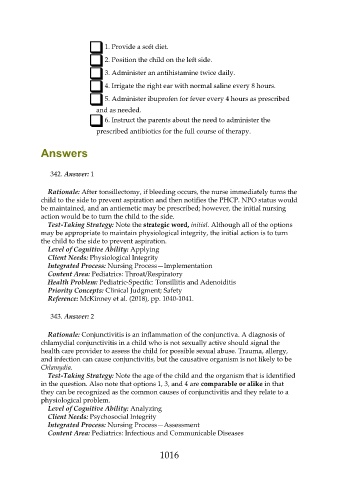Page 1016 - Saunders Comprehensive Review For NCLEX-RN
P. 1016
1. Provide a soft diet.
2. Position the child on the left side.
3. Administer an antihistamine twice daily.
4. Irrigate the right ear with normal saline every 8 hours.
5. Administer ibuprofen for fever every 4 hours as prescribed
and as needed.
6. Instruct the parents about the need to administer the
prescribed antibiotics for the full course of therapy.
Answers
342. Answer: 1
Rationale: After tonsillectomy, if bleeding occurs, the nurse immediately turns the
child to the side to prevent aspiration and then notifies the PHCP. NPO status would
be maintained, and an antiemetic may be prescribed; however, the initial nursing
action would be to turn the child to the side.
Test-Taking Strategy: Note the strategic word, initial. Although all of the options
may be appropriate to maintain physiological integrity, the initial action is to turn
the child to the side to prevent aspiration.
Level of Cognitive Ability: Applying
Client Needs: Physiological Integrity
Integrated Process: Nursing Process—Implementation
Content Area: Pediatrics: Throat/Respiratory
Health Problem: Pediatric-Specific: Tonsillitis and Adenoiditis
Priority Concepts: Clinical Judgment; Safety
Reference: McKinney et al. (2018), pp. 1040-1041.
343. Answer: 2
Rationale: Conjunctivitis is an inflammation of the conjunctiva. A diagnosis of
chlamydial conjunctivitis in a child who is not sexually active should signal the
health care provider to assess the child for possible sexual abuse. Trauma, allergy,
and infection can cause conjunctivitis, but the causative organism is not likely to be
Chlamydia.
Test-Taking Strategy: Note the age of the child and the organism that is identified
in the question. Also note that options 1, 3, and 4 are comparable or alike in that
they can be recognized as the common causes of conjunctivitis and they relate to a
physiological problem.
Level of Cognitive Ability: Analyzing
Client Needs: Psychosocial Integrity
Integrated Process: Nursing Process—Assessment
Content Area: Pediatrics: Infectious and Communicable Diseases
1016

